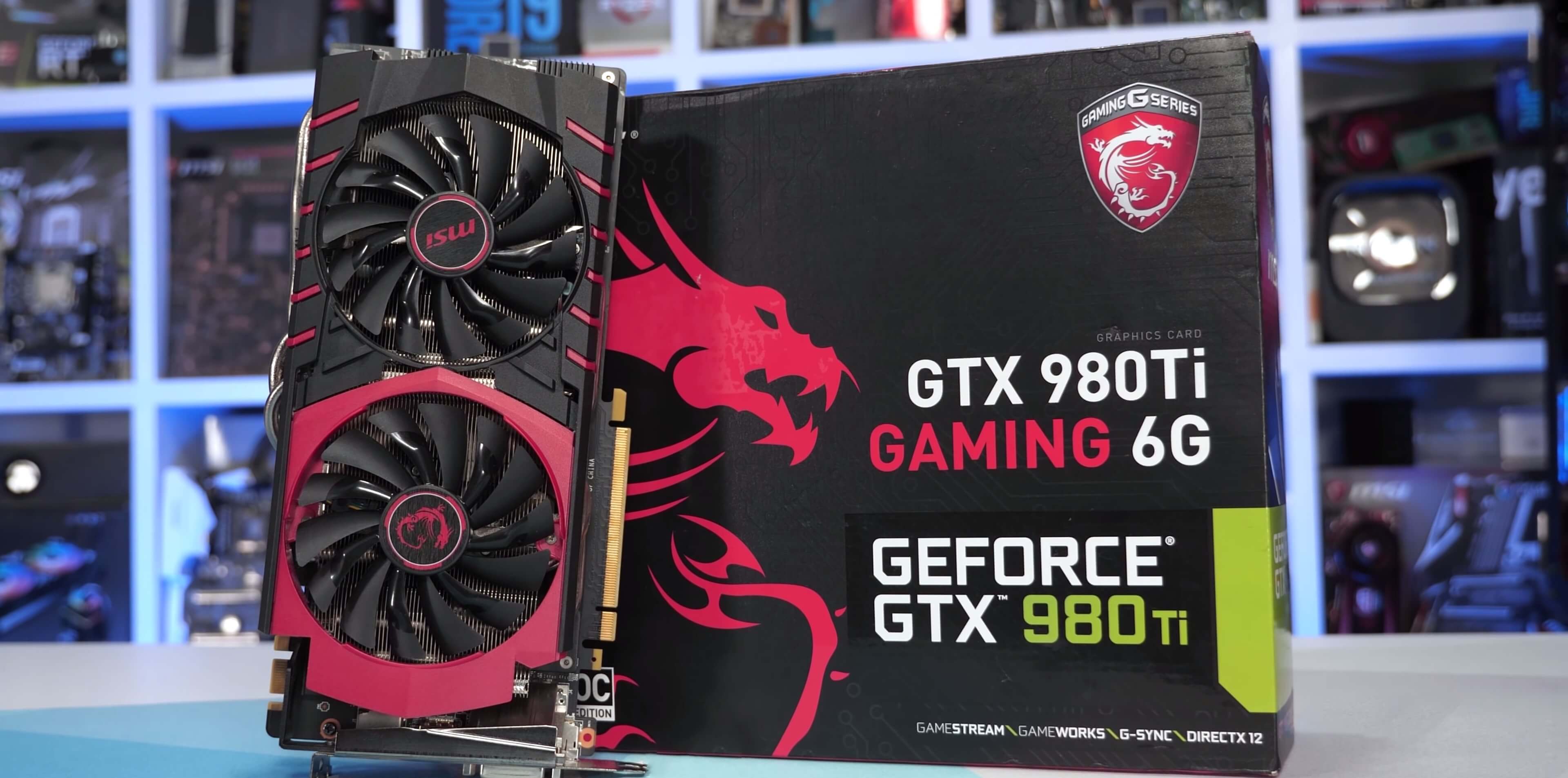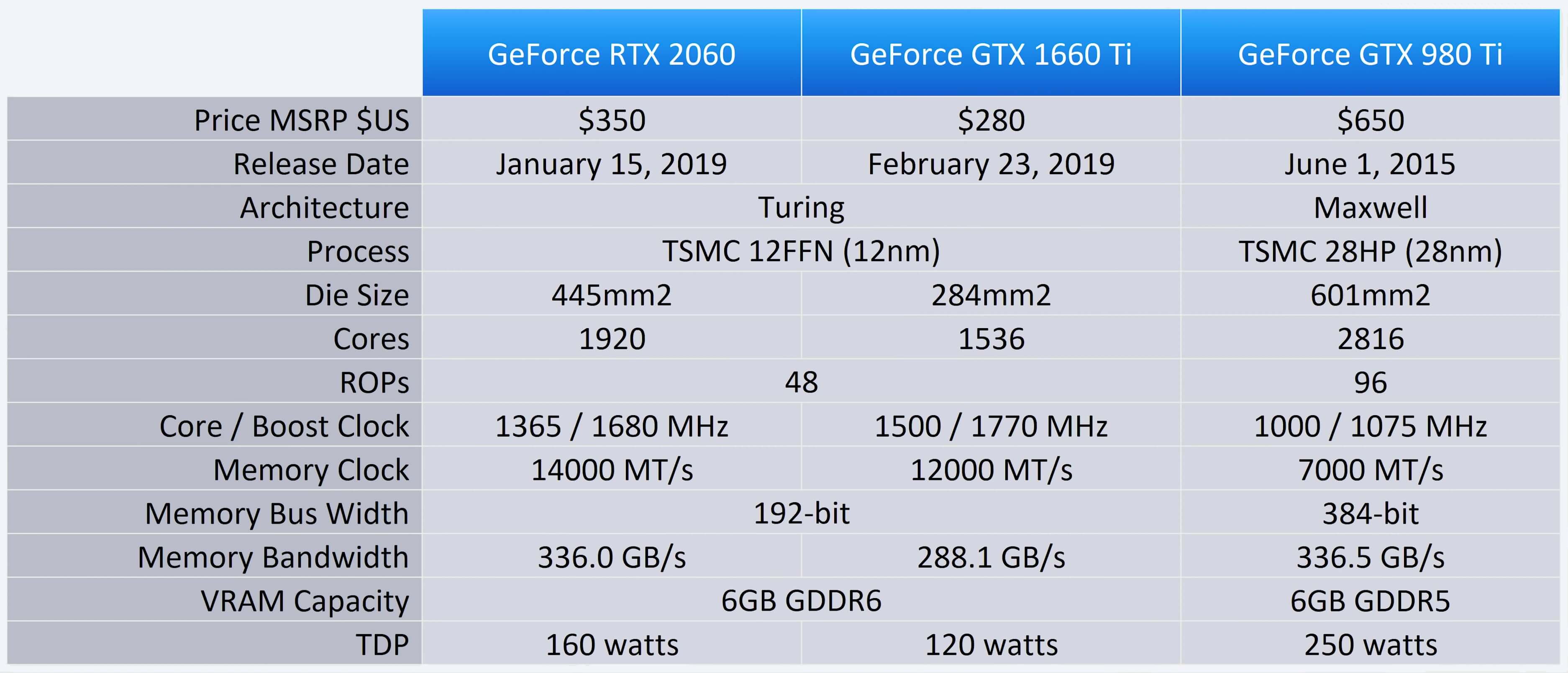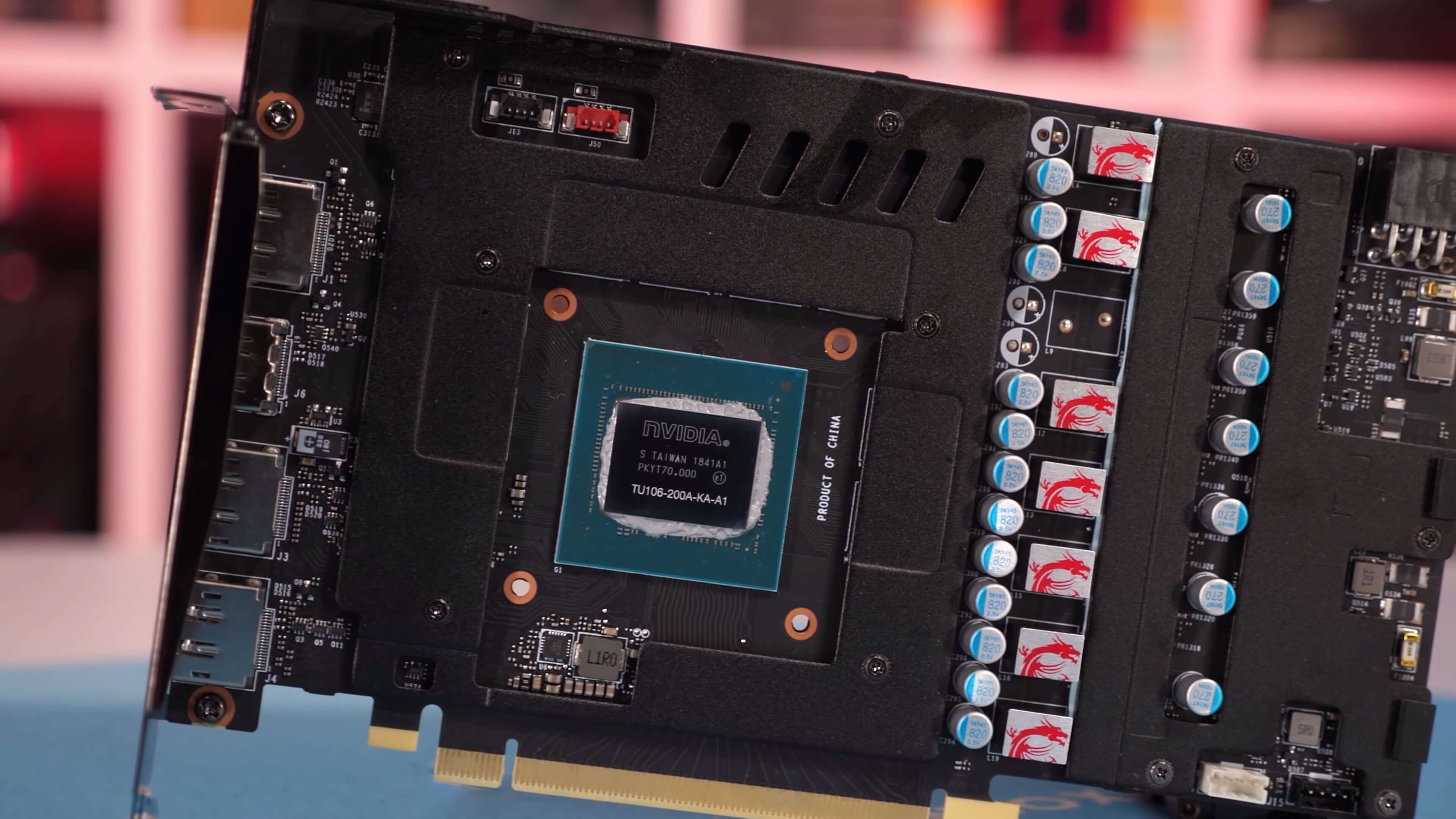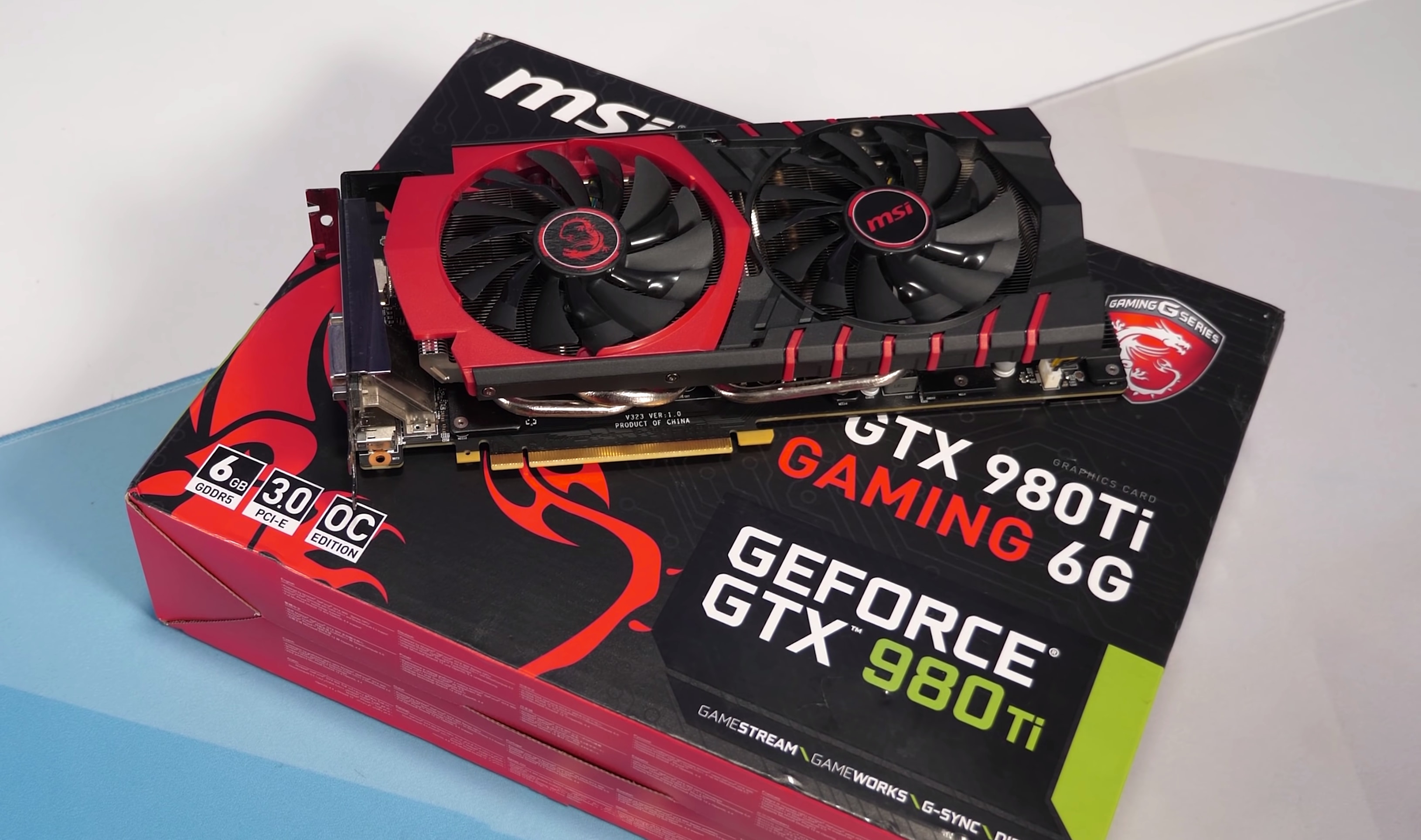Today we're revisiting an old friend, the GeForce GTX 980 Ti and we're doing so with a 36 game benchmark covering the 1080p and 1440p resolutions. We're particularly interested to see how it performs against more modern GPUs like the GTX 1070 and the GeForce RTX 2060. So in a way we suppose you could call this more of a GTX 980 Ti vs. GTX 1070 vs. RTX 2060 test.
About a year ago we reviewed the RTX 2060 for the first time. We happened to miss the official launch because Nvidia "lost" our sample in the mail but that meant we didn't have to rush our tests and we ended up with the full hog and provided a massive 36 game test.
Looking back at that data, we found that the RTX 2060 was able to beat the GTX 1070 Ti by a slim margin, making it 13% faster than the vanilla GTX 1070. We didn't include older GPUs at the time like the GTX 980 Ti, so the Maxwell-based flagship was absent from that feature. It will be interesting to see if those margins have changed, while also taking a look at how much faster the RTX 2060 is when compared to the GTX 980 Ti.
The GTX 980 Ti was released back in mid-2015 for $650 and the RTX 2060 in early 2019 for $350. That makes the modern Turing GPU three and a half years newer and almost 50% cheaper. The 980 Ti was a beast of a GPU, it shared the same 601mm2 die with the Titan X and although not all SM units were enabled, it still packed an impressive 2816 CUDA cores, 6GB of GDDR5 memory on a 384-bit wide memory bus, and enjoyed a memory bandwidth of 336.5 GB/s.
A year later the GTX 1070 arrived and although it packed just 1920 CUDA cores – 32% fewer than the 980 Ti – thanks to a ~60% increase in clock speed, performance ended up being very similar and this was largely due to Nvidia moving from TSMC's 28nm process to what at the time was their latest 16nm manufacturing.
The jump to the 12nm process with the RTX 2060 was less extreme, but here we got an entirely new architecture. Notably, the RTX 2060 die is 42% larger than the GTX 1070 and although the core count has only increased by a little over 10%, the cores are much wider and support technologies such as real-time ray tracing.
Despite the massive increase in die size, Nvidia sold the RTX 2060 for a little less than the Pascal-based GTX 1070. In a way they had to, as the newer GPU had more features but was just marginally faster. Turing is the more modern architecture, featuring better support for DX12 and Vulkan. So again, it'll be interesting to see if that margin has grown and where – in other words, which games are favoring Turing today.
Our test setup consists of the MSI GTX 980 Ti Gaming (graphics card names were a little simpler back then) pitted against the MSI RTX 2060 Gaming Z and GTX 1070 Gaming X. Powering the GPU test rig is the Intel Core i9-9900K overclocked to 5 GHz with 16GB of DDR4-3400 memory. As usual, rather than having 36 individual graphs, we'll look at about a dozen of the more interesting games and then jump into the performance breakdown graphs. For the discussion, we'll be focusing on the 1440p results...
Benchmarks
Doom Eternal is an interesting game to start with as it makes heavy use of async compute and this is a technology neither the Maxwell or Pascal architectures were able to utilize at the hardware level.
At 1440p the key advantage the GTX 1070 has over the 980 Ti is the 8GB VRAM buffer, that and what is likely better driver optimization. The end result means the 980 Ti was almost 20% slower. However it's the RTX 2060 and it's more modern architecture that really excels in this title, reaching almost 100 fps on average and that meant the 980 Ti was 31% slower.
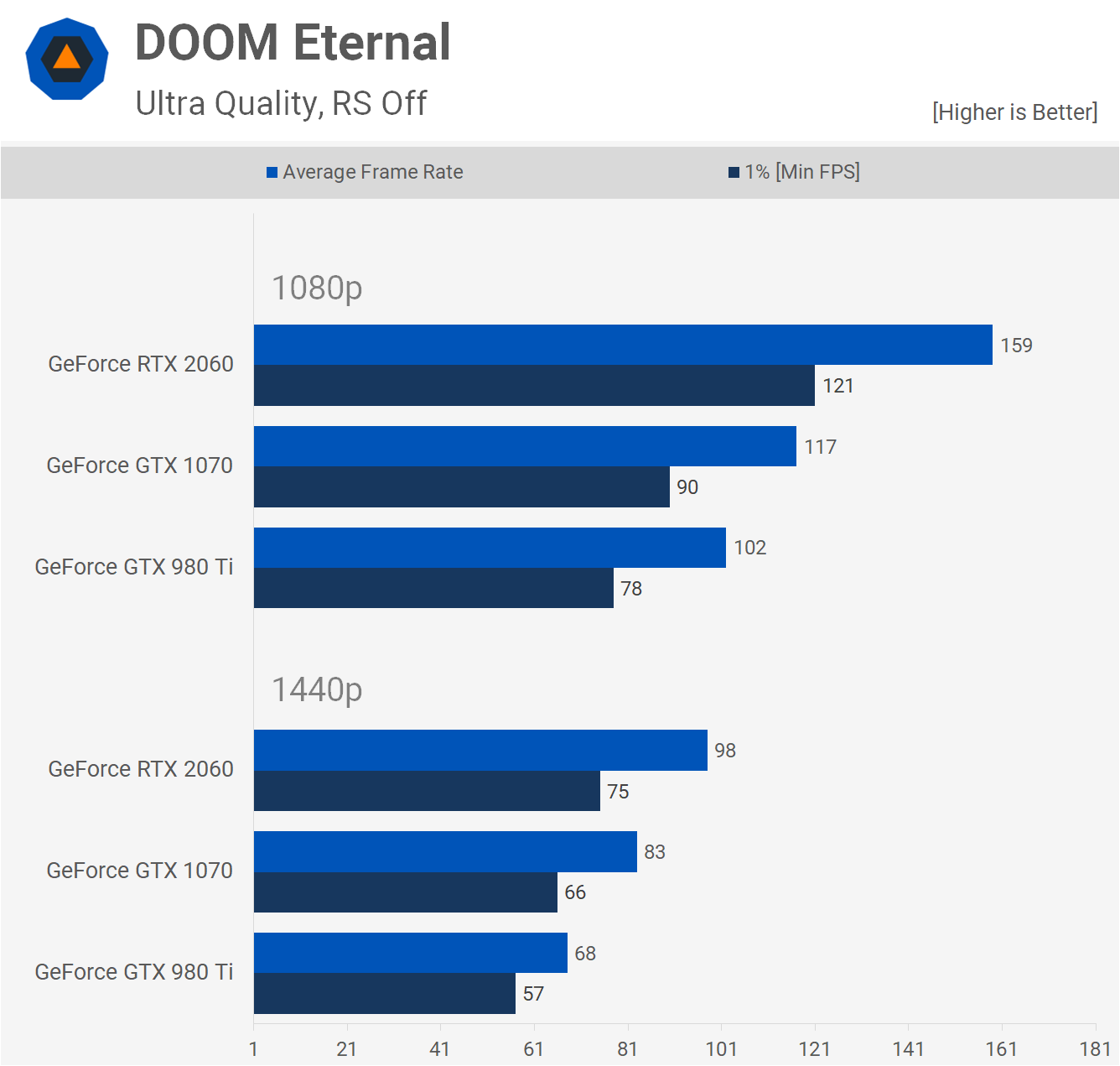
It's also worth noting that the 2060 makes out even better at 1080p as the 980 Ti is also limited to a 6GB memory buffer. Whereas it was 18% faster than the GTX 1070 at 1440p, it's a whopping 36% faster at 1080p as the memory constraints are less of an issue at this lower resolution.
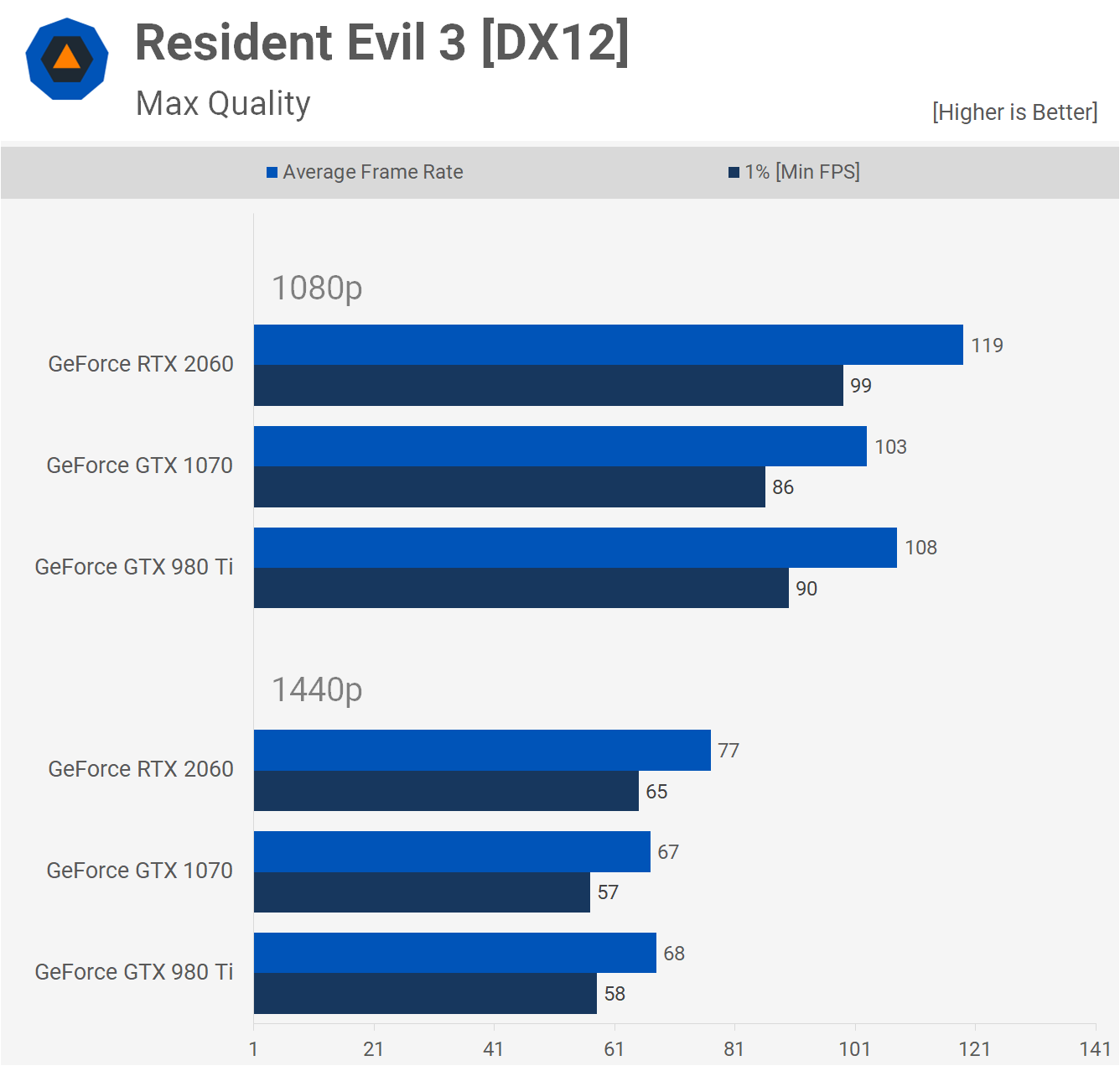
Moving to Resident Evil 3 we find a situation where the GTX 1070 is no faster than the GTX 980 Ti. If anything, it's a little slower. This was also the case with Resident Evil 2 – both games use the same engine and look very similar.
With 68 fps on average at 1440p, the 980 Ti fairs very well in this title. The RTX 2060 was faster, but this time by just a 13% margin, so while that is certainly progress, it's not a ton of it.
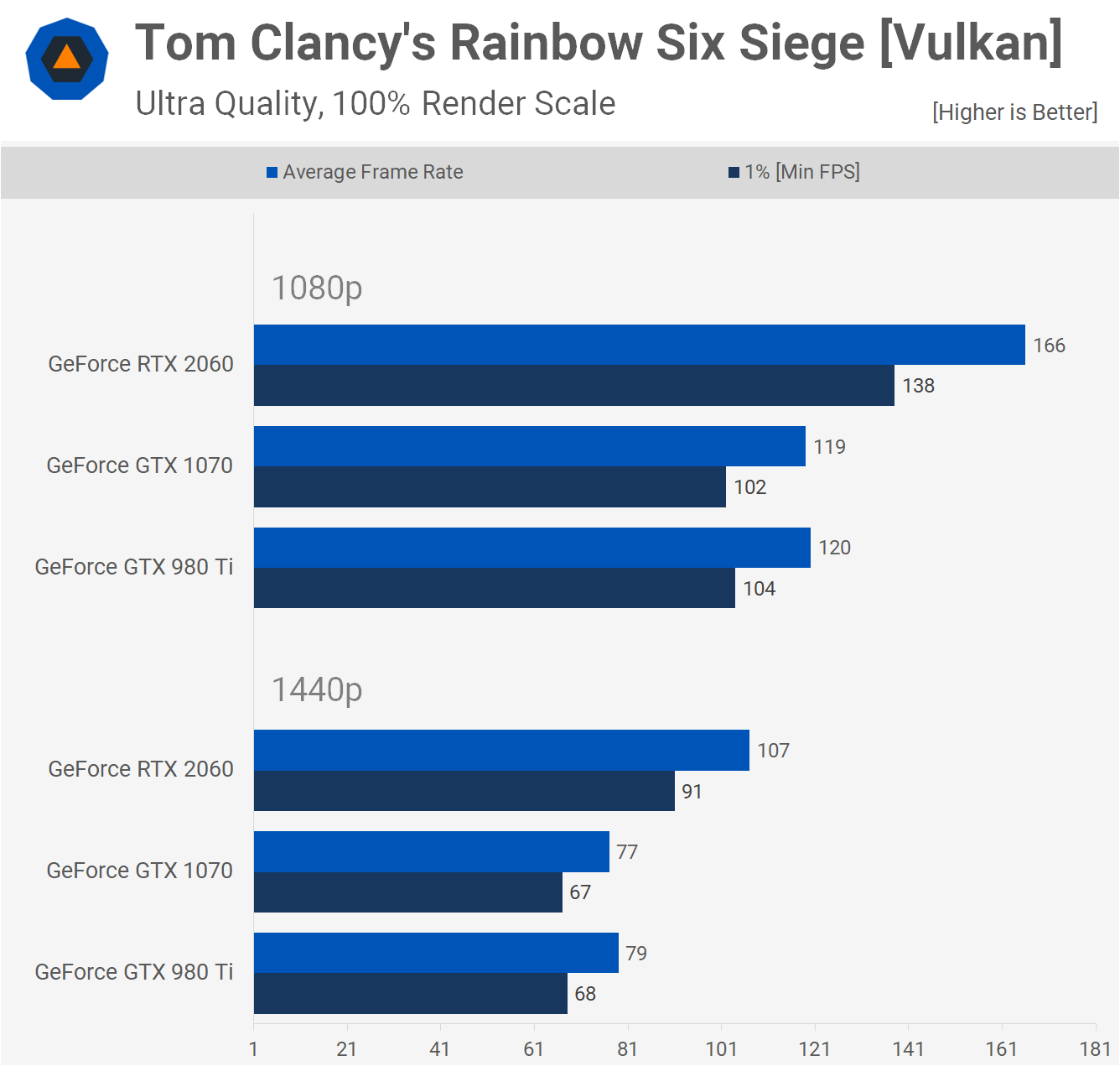
Where we do see a significant step forward for the Turing based GPU is in Rainbow Six Siege. Here the RTX 2060 was a whopping 35% faster than the GTX 980 Ti and almost 40% faster than the GTX 1070.
Rainbow Six Siege is a compute-heavy title and previously this meant AMD's 5th gen GCN products walked all over Nvidia's Pascal GPUs, such as the GTX 1070. However the upgraded Turing cores tackled that weakness and now it's Nvidia who enjoys an advantage in this title, even when compared to Radeon Navi GPUs.
The leap forward seen here is incredible, though it has to be said, with 79 fps on average the GTX 980 Ti still delivered impressive performance at 1440p.
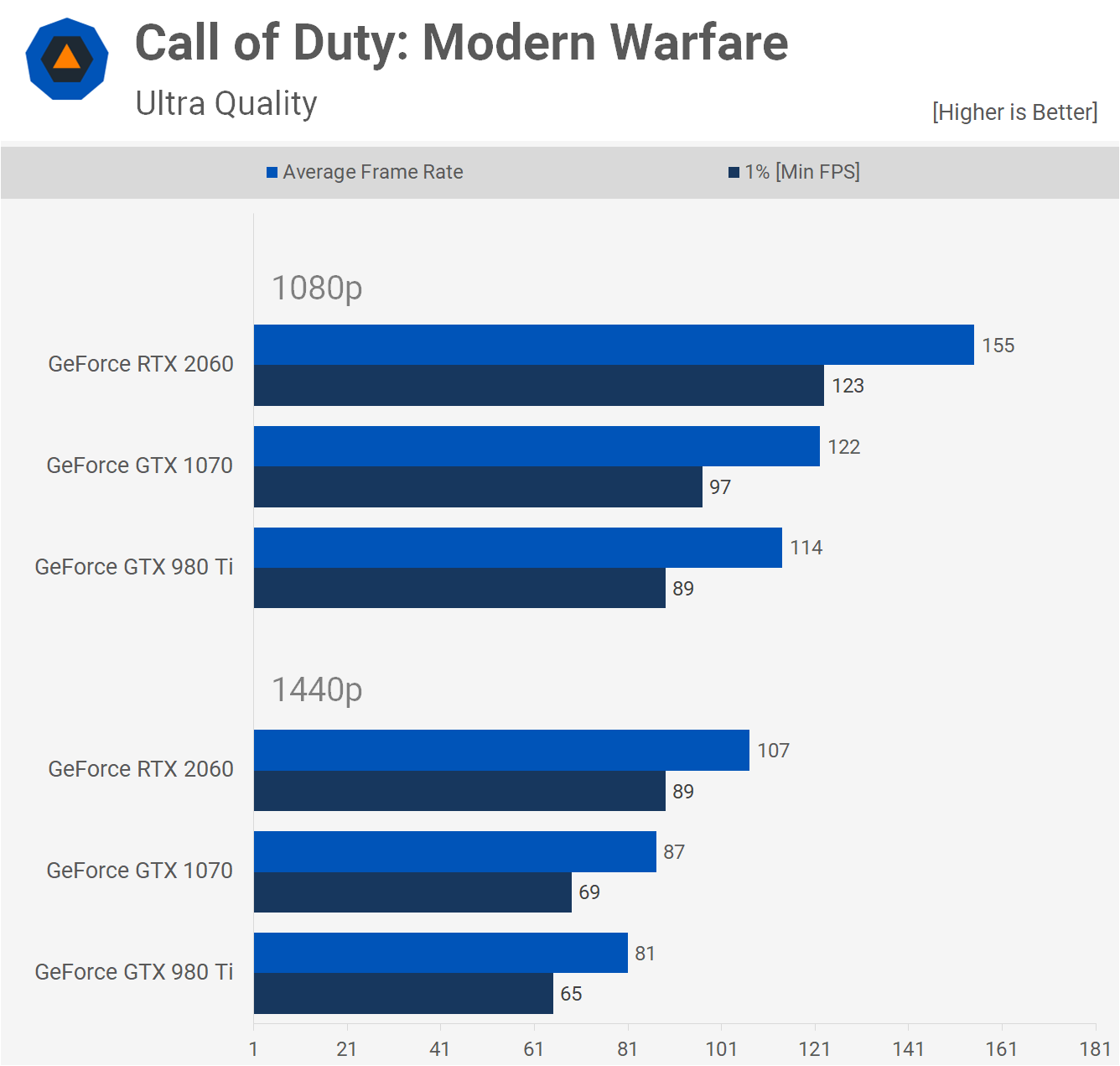
The 980 Ti also performs very well in Call of Duty: Modern Warfare, spitting out over 60 fps at all times during our test, for an average of 81 fps. It was also just 7% slower than the GTX 1070, though it did trail the much newer RTX 2060 by a 24% margin.
The RTX 2060 does perform well in this title, even at 1440p and a 23% performance uplift over the GTX 1070 is certainly nothing to sneeze at.
This game also supports ray tracing and is therefore heavily optimized for Turing. We've witnessed Pascal GPUs such as the GTX 1060 performing quite poorly relative to competitors, in this case the RX 580. So while we're sure Turing improvements help here, we'd wager that driver optimization is playing its role as well.
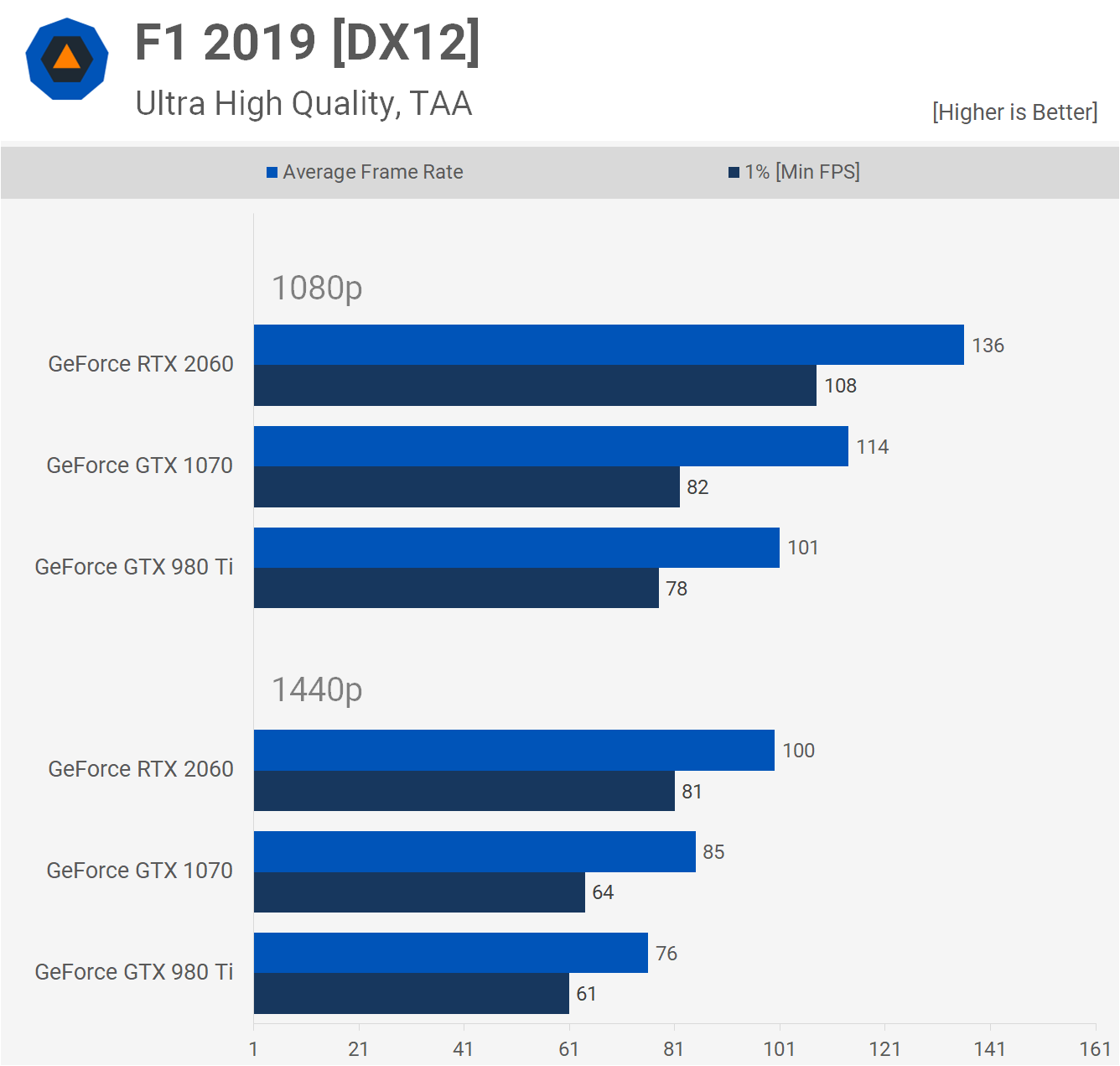
The GTX 980 Ti performed well in F1 2019 using the new DX12 mode, here it was just 11% slower than the GTX 1070, but more importantly was able to provide smooth playable performance at 1440p with 76 fps on average. The RTX 2060 was 32% faster and 18% faster than the GTX 1070, so a reasonable performance uplift in this latest F1 title.
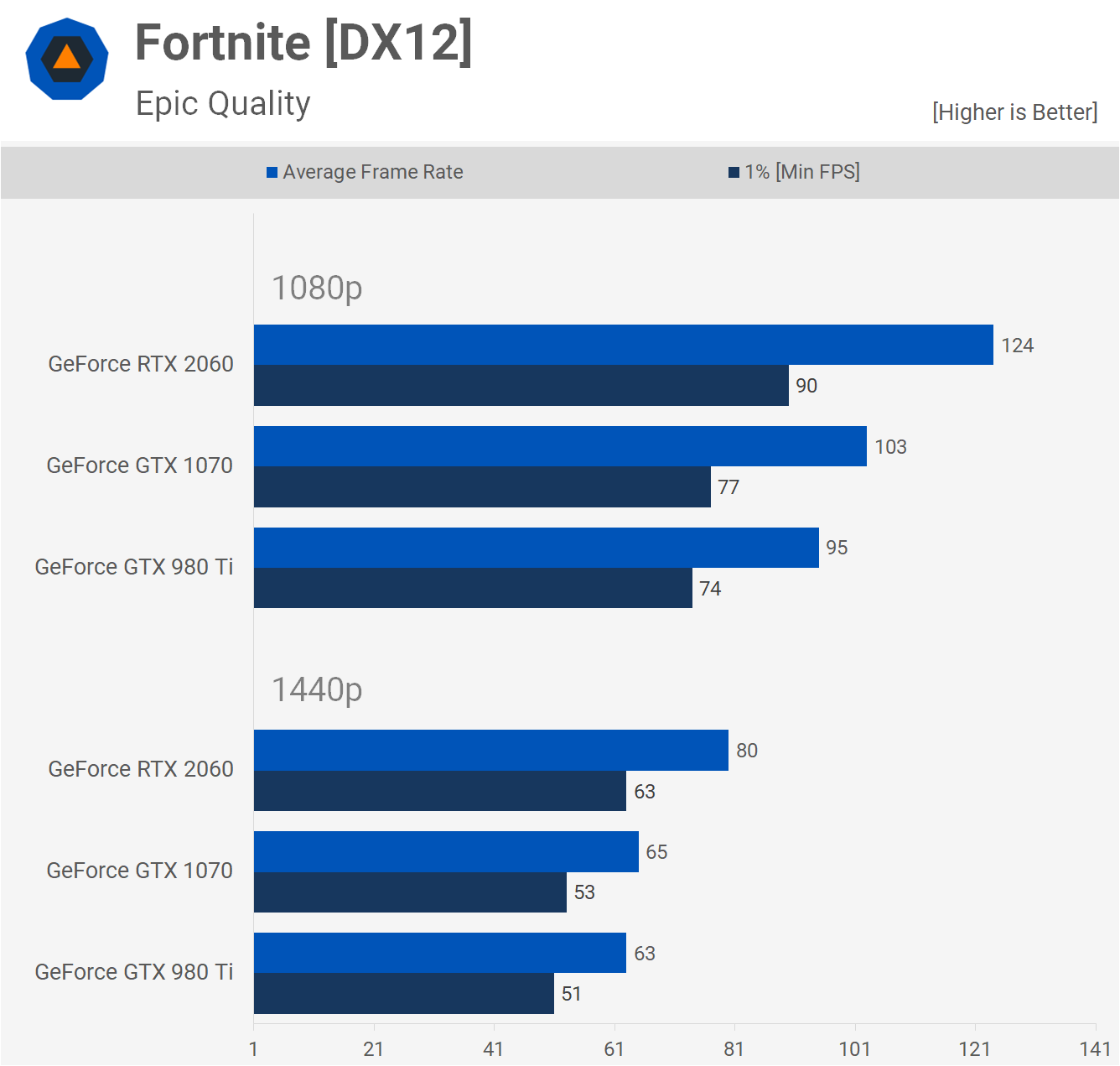
Fortnite also supports DX12 now and using this API we see comparable performance between the GTX 980 Ti and GTX 1070 at 1440p using the maximum quality preset. For competitive-type quality settings either will work just fine.
The RTX 2060 does offer a 23% performance boost and perhaps not the kind of gain you'd expect to see in this title.
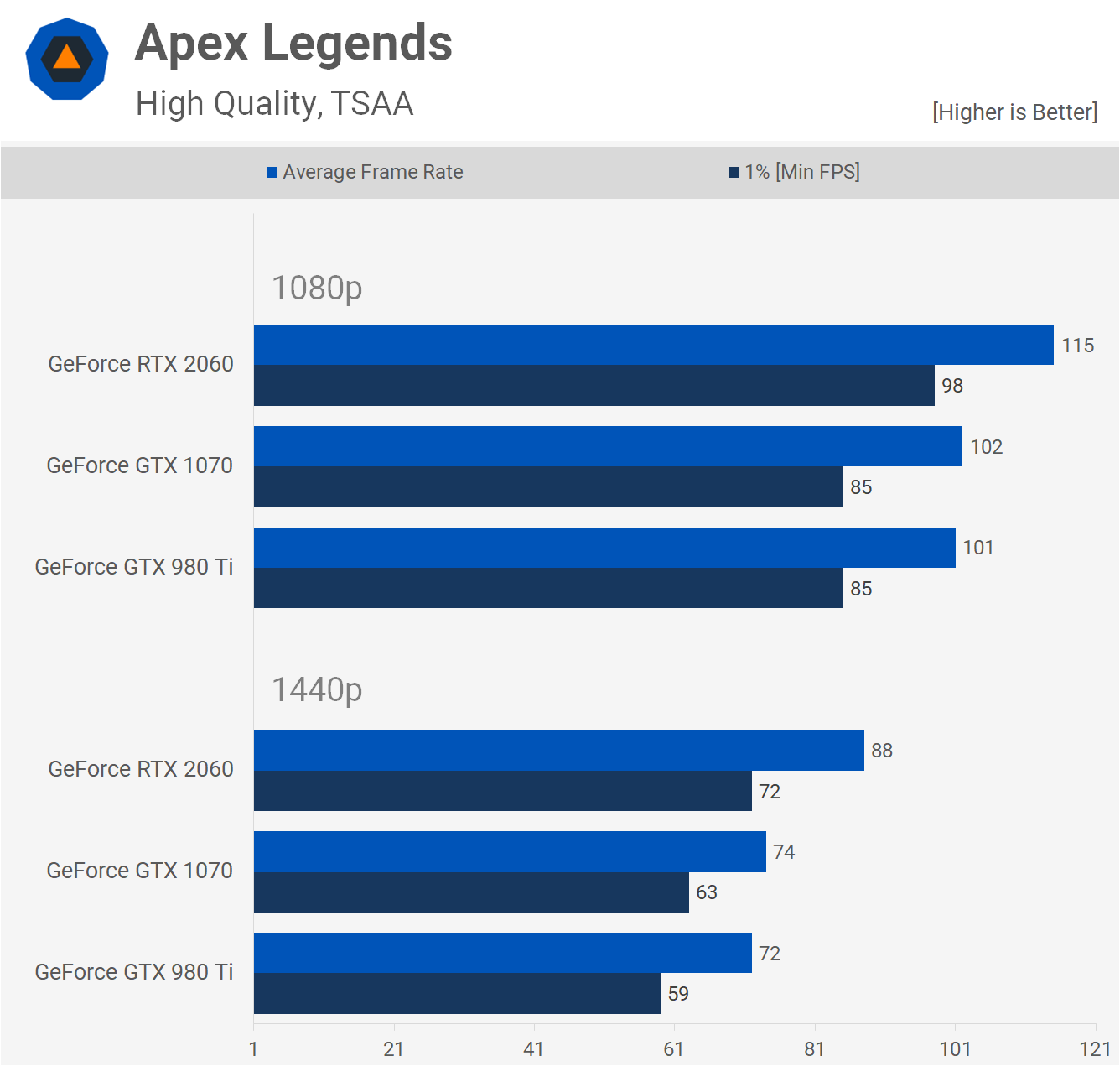
Another popular battle royale game where the GTX 1070 and 980 Ti are evenly matched. Both GPUs average just over 70 fps. The RTX 2060 was about 20% faster at 1440p, which is a strong performance lead and certainly not a bad generation-on-generation performance uplift.

Shadow of the Tomb Raider remains a visually impressive game even when it's been 18 months since it launched. As you can see it's a demanding one, even at 1440p. Here the 980 Ti failed to achieve a 60 fps average, as did the GTX 1070, both rendering just over 50 fps. This made the 23% boost offered by the RTX 2060 quite noticeable.

World War Z is yet another title where the GTX 1070 and 980 Ti are very evenly matched and it's another title where both easily push above 60 fps at 1440p using the maximum in game quality settings. The RTX 2060 was around 18% faster so a reasonable performance uplift there, but it has to be said the 980 Ti hardly looks outdated.

The Gears 5 results are interesting, the GTX 1070 is clearly faster than the 980 Ti at 1080p, offering a 12% performance upgrade. However at 1440p the results come together and here the 1070 is just 6% faster, verging on a margin of error-type difference. The RTX 2060 is just 13% faster than the GTX 1070, though we see a similar margin between the two at both tested resolutions.
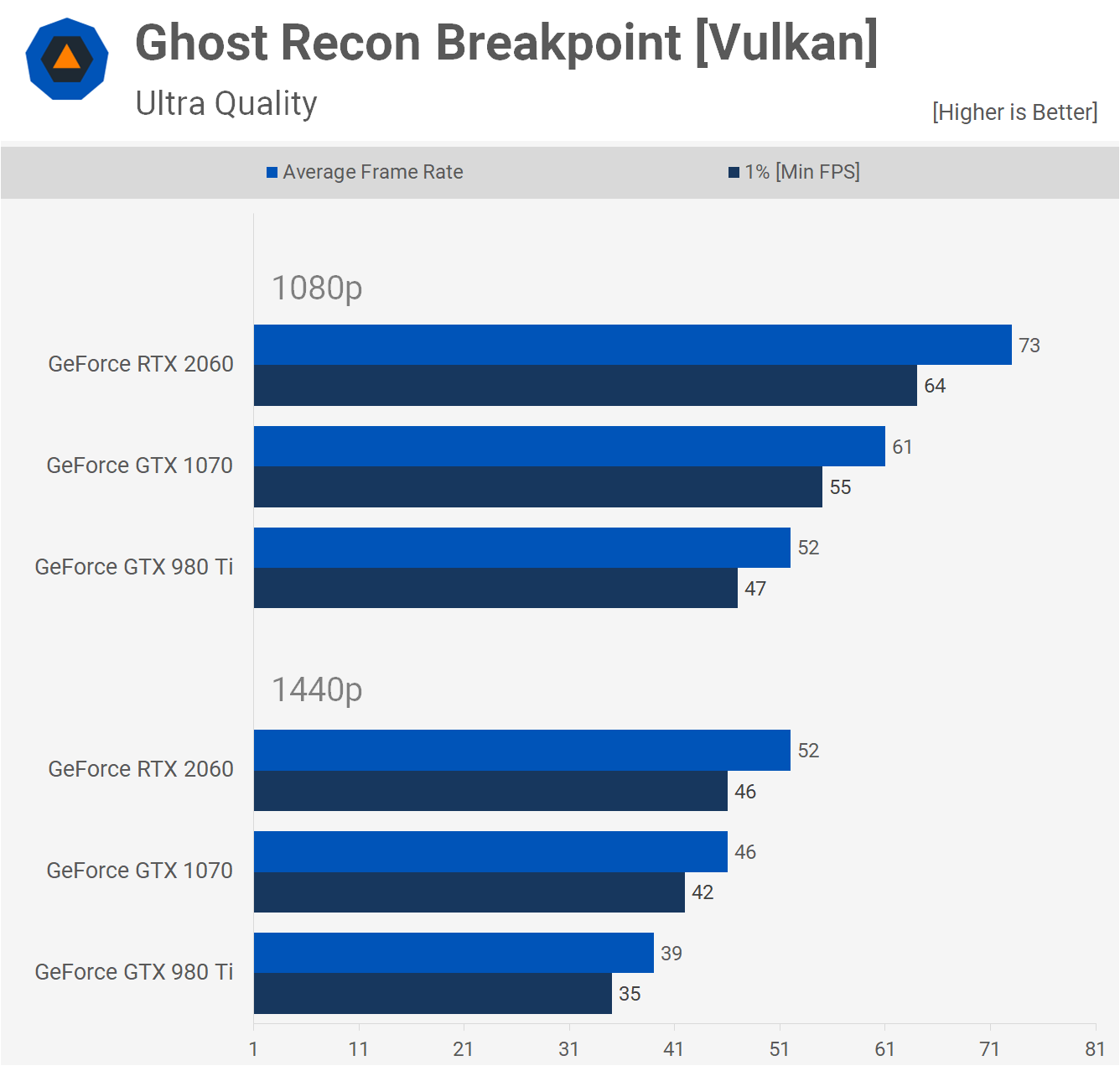
Ghost Recon Breakpoint has recently been updated to support Vulkan and this has led to big performance gains for modern GeForce GPUs – gains of up to 20%.
It seems clear that Nvidia has not optimized for the 980 Ti and Maxwell as the GTX 1070 was a whopping 18% faster at 1440p. A similar result to what we saw with another new title, Doom Eternal.

Last up we have World of Tanks and as is often the case with older titles, we see very little difference in performance between the three GPUs, particularly at 1440p. We're talking a 10% or lower margin between the slowest and fastest GPU. This can be attributed to better driver optimization for older GPUs and or the inability to take advantage of modern features supported by newer GPUs.
For the most part the GTX 980 Ti still looks to be handling itself rather well, though there are some titles such as Ghost Recon Breakpoint, which appear to lack proper driver optimization and therefore will require gamers to reduce graphics settings for smooth performance at 1440p. Since we've only looked at a dozen of the tested games, let's see how these GPUs compared across all 36 games.
Performance Breakdown

At 1080p, the GTX 980 Ti was on average 5% slower than the GTX 1070. The only outlier here was The Division 2 where the 980 Ti was for 26% slower for some reason.
Removing that result changes the average by a single percent, making the 980 Ti ~4% slower. For the most part, you're looking at little to no difference between these two GPUs, 21 of the 36 games tested saw a margin of 5% or less which we typically deem a draw.
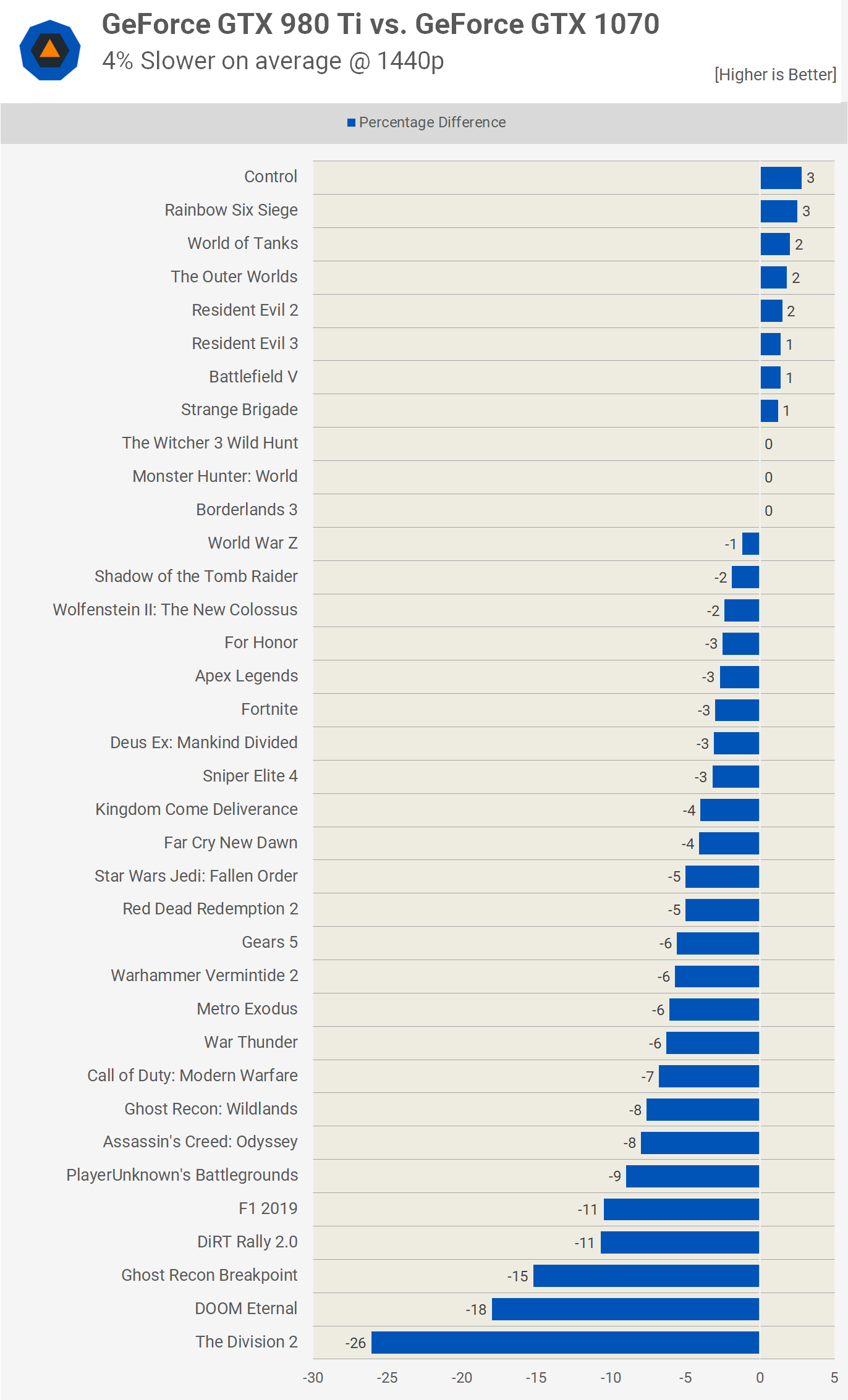
Moving to 1440p reduces the margin to 4% and removing The Division 2 doesn't change anything in that average. 22 of the 36 games saw a margin of 5% difference or less, which confirms these GPUs are very evenly matched.
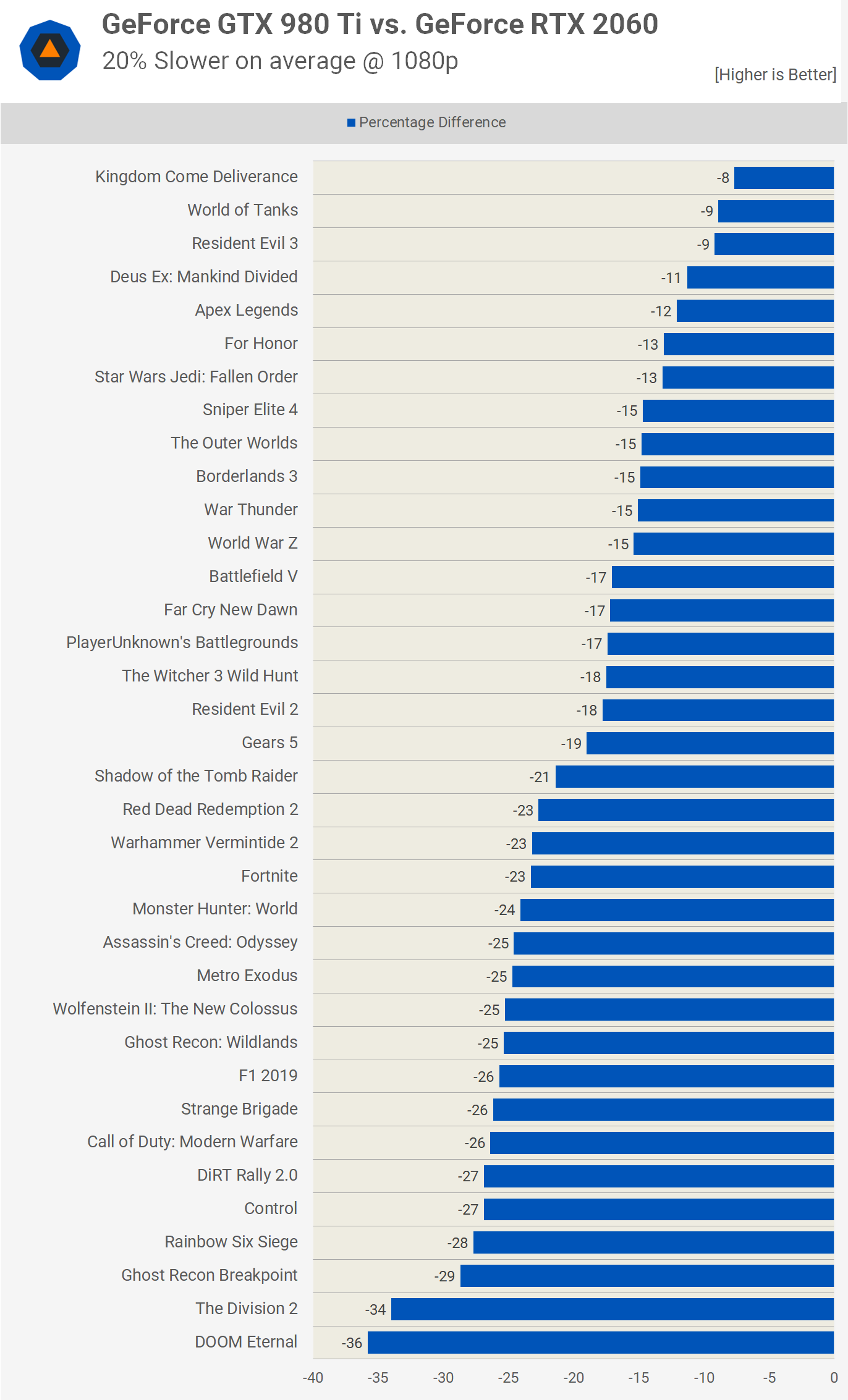
When compared to the RTX 2060, the GTX 980 Ti was 20% slower on average at 1080p. The Division 2 along with Doom Eternal are weak titles for the Maxwell part.

The old GTX 980 Ti trails the RTX 2060 by a similar margin at 1440p. For this match up it was 19% slower on average. Certainly it's on the more demanding, newer, or more technically advanced games where the RTX 2060 gets away from the GTX 980 Ti.
The margins are much smaller in titles such as World of Tanks, War Thunder, For Honor and Resident Evil 3, for example. Whereas they're quite considerable in titles such as Doom Eternal, The Division 2, Control, DiRT Rally 2.0, Strange Brigade, Rainbow Six Siege, Red Dead Redemption 2, Assassin's Creed Odyssey, Call of Duty: Modern Warfare, and well... a few others, you get the point.
What We Learned
While the GTX 980 Ti is starting to show its age, the once mighty flagship GPU still has some fight in it, which is great to see. We have to admit, the initial intention of this benchmark session was to investigate how well the 980 Ti stacked up against the newer GTX 1070 in 2020, we often found ourselves more interested in the battle between the GTX 1070 and RTX 2060.
But we'll stop ourselves from jumping right to that and talk a little more about the 980 Ti versus the GTX 1070. Last time we compared these two head to head in a large range of games the 980 Ti was actually 1% faster or basically identical and that's still mostly true today. The games that tipped the results in the 1070's favor include The Division 2, Ghost Recon Breakpoint and Doom Eternal.
None of those titles were tested before and in our opinion the 980 Ti probably shouldn't be that much slower, so we suspect this is a result of Nvidia failing to optimize for older hardware.
The GTX 980 Ti is 5 years old now and we're pretty confident that Nvidia abandons all optimizations around the 6 year old mark. This can be seen when looking at Kepler-based GPUs. We suspect we're getting to a point where the GeForce 900 series will start to fall away in newer titles. If you happen to be second-hand shopping, keep that in mind.
Lets now shift gears to the RTX 2060...
Upon release we found it was ~13% faster than the GTX 1070. In today's test the RTX 2060 was 20% faster on average, so which games are responsible for the overall improvement in performance?
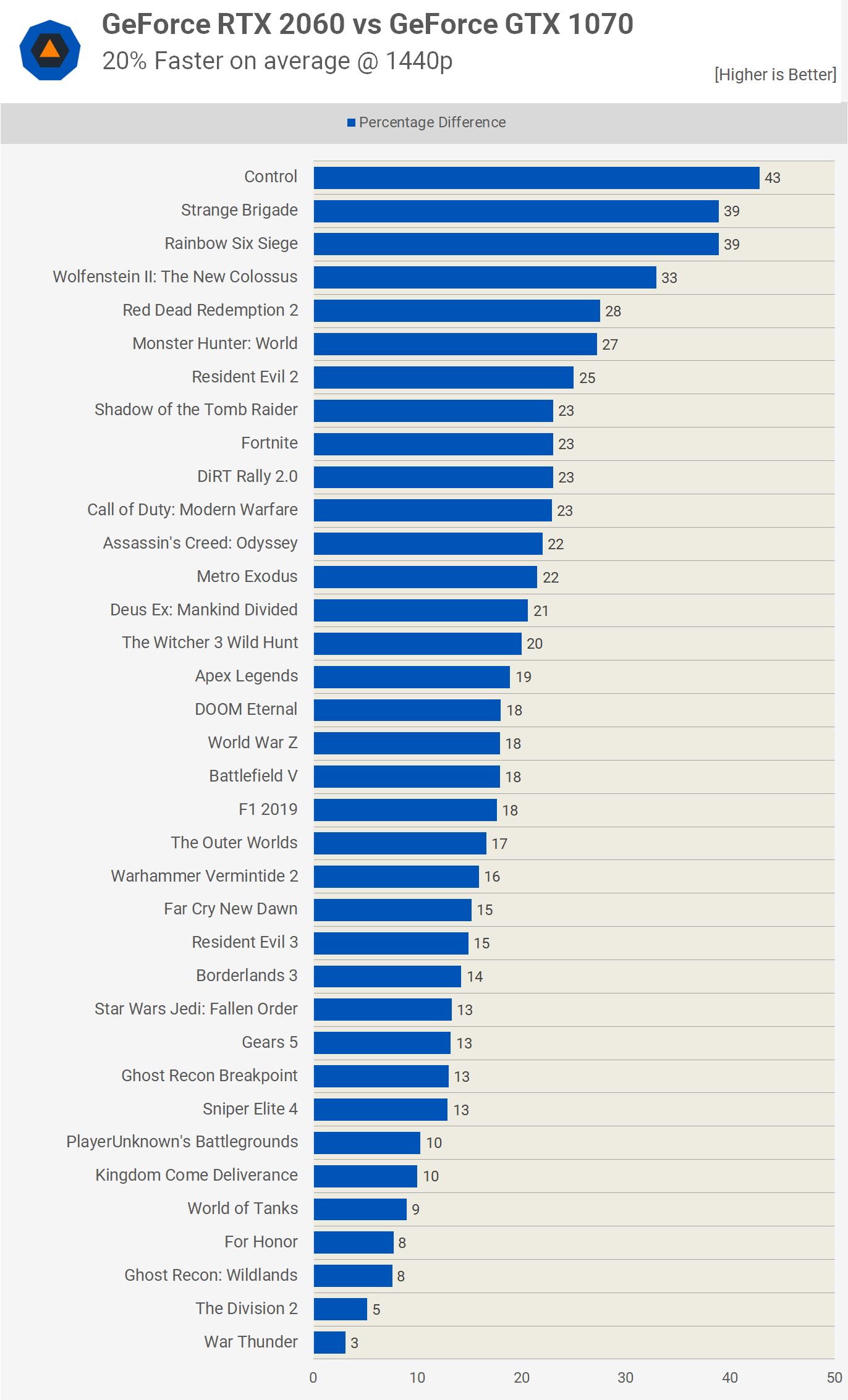
The biggest contributor is Control, a newer title that wasn't part of the previous test. Control is also an Nvidia sponsored title and a great deal of time has been invested into making sure RTX series GPUs deliver maximum performance, largely so ray tracing doesn't result in a complete slideshow.
Interestingly, Strange Brigade performance has also been dramatically improved and this title does make use of async compute. Although not a popular title, it is often used for benchmarking, so it doesn't surprise me that Nvidia has made an effort to optimize performance for Turing-based GPUs here.
The RTX 2060 was also 39% faster in Rainbow Six Siege, but that's not much different to the 33% win it enjoyed using the older DX11 version. Nvidia has optimized Turing for Wolfenstein: The New Colossus, originally the 2060 was 20% faster, now with upgraded drivers and multiple game patches, it's 33% faster. Red Dead Redemption 2 is another new game that massively favors the 2060.
Between new games that better utilize modern GPUs and Nvidia's focus on driver optimizations for Turing, the RTX 2060 has been able to further distance itself from the GTX 1070 and consequently the GTX 980 Ti. For those of you still rocking the GTX 980 Ti, overall we'd say it's holding up well and you're probably reasonably satisfied with the experience, but we suspect it'll start to fall away now and upcoming generations should see it outpaced for around $200.
The GeForce GTX 1070 is still a solid buy but with Nvidia focusing its attention on Turing and future generations supporting ray tracing and DLSS, it'll be interesting to see how well Pascal ages over the next few years. No doubt, we'll have plenty more benchmark content in the future that will monitor the situation.
